
Oxyria digyna is a species of flowering plant in the buckwheat family (Polygonaceae). It is native to arctic regions and mountainous parts of the Northern Hemisphere.

Xerophyllum tenax is a North American species of plants in the corn lily family. It is known by several common names, including bear grass, soap grass, quip-quip, and Indian basket grass.

Maianthemum racemosum, the treacleberry, feathery false lily of the valley, false Solomon's seal, Solomon's plume or false spikenard, is a species of flowering plant native to North America. It is a common, widespread plant with numerous common names and synonyms, known from every US state except Hawaii, and from every Canadian province and territory, as well as from Mexico.

Holodiscus discolor, commonly known as ocean spray or oceanspray, creambush, or ironwood, is a shrub of western North America.
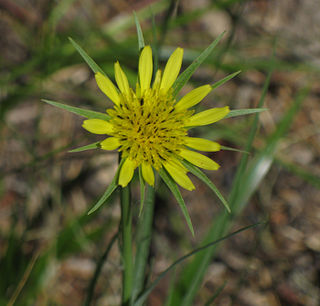
Tragopogon dubius is a species of salsify native to southern and central Europe and western Asia and found as far north and west as northern France. Although it has been reported from Kashmir and India, recent evidence suggests that specimens from these areas may be a different species. Western salsify has been introduced into North America where it has become widespread, being reported from all the continental United States except for a few in the far south-east, and all provinces of Canada except Newfoundland and the northern territories.

Spiraea splendens is a shrub of the rose family (Rosaceae) native to the western mountains of North America, from California to British Columbia, commonly known as dense-flowered spiraea, rose meadowsweet, rosy spiraea, subalpine spiraea, and mountain spiraea. It is commonly found at elevations between 2,000 feet (610 m) and 11,000 feet (3,400 m) on inland mountain ranges. The plant is adapted to cold, moist, rocky slopes, subalpine forests and meadows.

Ranunculus glaberrimus, the sagebrush buttercup, is a species of flowering plant in the buttercup family, Ranunculaceae. It is native to interior western North America, in western Canada, the western United States, and the northwestern Great Plains.

Claytonia lanceolata is a species of wildflower in the family Montiaceae, known by the common names lanceleaf springbeauty and western springbeauty.

Primula conjugens, synonym Dodecatheon conjugens, is a species of flowering perennial plant in the primrose family, known by the common name Bonneville shooting star.
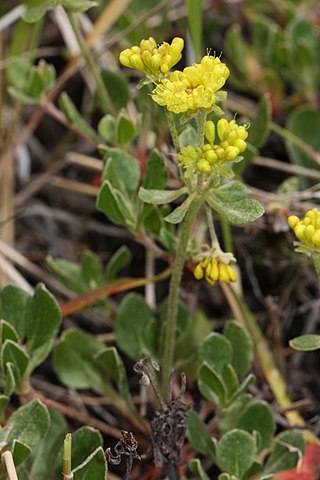
Eriogonum umbellatum is a species of wild buckwheat known by the common name sulphurflower buckwheat, or simply sulphur flower. It is native to western North America from California to Colorado to central Canada, where it is abundant and found in many habitats, including the sagebrush steppe and alpine areas. It is an extremely variable plant and hard to identify because individuals can look very different from one another. Also, there are many varieties. It may be a perennial herb blooming by summer with stems 10 centimeters tall and two to six clusters of flowers, with a whorl of leaves below the stems, or a sprawling shrub approaching two meters high and wide. The leaves are usually woolly and low on the plant, and the flowers come in many colors from white to bright yellow to purple.
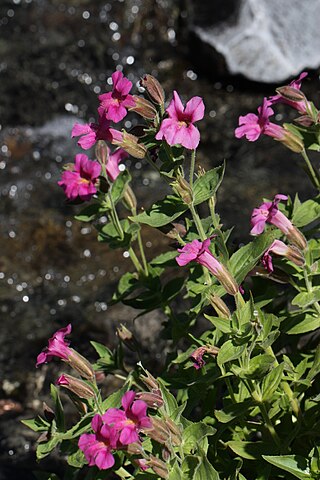
Erythranthe lewisii is a perennial plant in the family Phrymaceae. It is named in honor of explorer Meriwether Lewis. Together with other species in Erythranthe, it serves as a model system for studying pollinator-based reproductive isolation. It was formerly known as Mimulus lewisii.

Erythronium grandiflorum is a North American species of plants in the lily family. It is known by several common names, including yellow avalanche lily, glacier lily, and dogtooth fawn lily. The Ktunaxa name for glacier lily is maxa.

Senecio triangularis, known as arrowleaf ragwort, arrowleaf groundsel and arrowleaf butterweed, is a species of the genus Senecio and family Asteraceae.

Prosartes trachycarpa, the roughfruit fairybells, rough-fruited fairybells or rough-fruited mandarin, is a North American species of plants in the lily family. The species is widespread, known from British Columbia to Ontario and south to Arizona and New Mexico. One isolated population was reported from Isle Royale in Lake Superior.

Phacelia sericea, the silky phacelia or blue alpine phacelia, is a showy perennial species of Phacelia endemic to western North America. It grows mainly at subalpine to alpine elevations in forest openings or above treeline among rocks and sand. Sericea comes from the Latin sericeus, or silky, referring to the fine hairs on the leaves and stem.
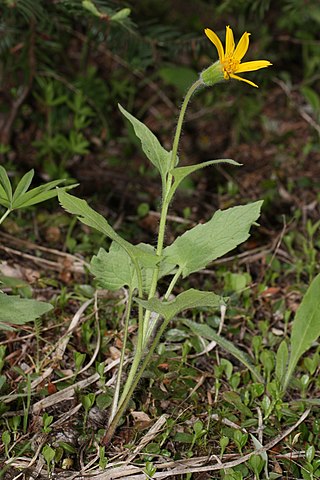
Arnica cordifolia is a species of arnica in the sunflower family, known by the common name heartleaf arnica. It is native to western North America.
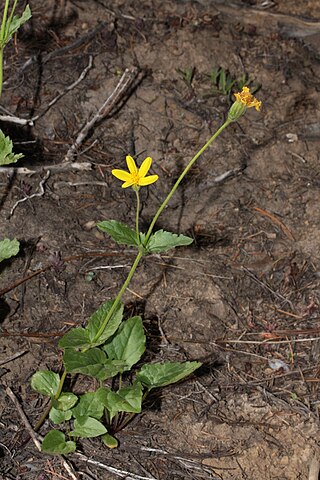
Arnica latifolia is a species of arnica in the sunflower family, known by the common names broadleaf arnica, broad leaved arnica, mountain arnica, and daffodil leopardbane. It is native to western North America from Alaska east to Northwest Territories and south to Mono County, California, and Taos County, New Mexico. It grows in mountain habitat such as forest and meadows.

Calochortus elegans is a species of flowering plant in the lily family known by the common name elegant Mariposa lily, cat's ear, elegant cat's ears or star tulip. It is native to the western United States from northern California to Montana.
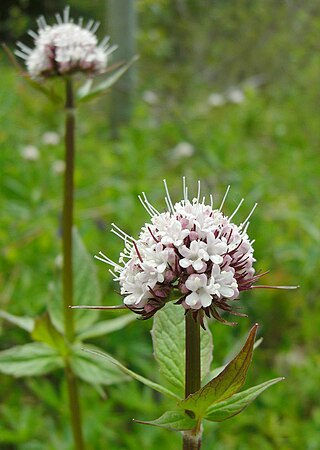
Valeriana sitchensis is a species of valerian known by the common name Sitka valerian. It is native to northwestern North America from Alaska and northern Canada to Montana to northern California, where it grows in many types of habitat, including moist mountain forests. In moist subalpine meadows, it is often one of the most common plants. This is a rhizomatous perennial herb producing a stout, erect stem to about 70 centimeters in maximum height, but known to exceed one meter at times. The leaves vary in size and shape, often having deep lobes or being composed of several leaflets. The inflorescence is a cyme of many white or pink-tinged flowers, each under a centimeter wide. The flower has five corolla lobes and three whiskery stamens protruding from the center.
Cirsium foliosum , also called leafy thistle, foliose thistle, elk thistle, or Evert's thistle, is a North American plant species in the tribe Cardueae within the family Asteraceae. The species is native to Alaska, Yukon, Northwest Territories, Alberta, British Columbia, and Wyoming.




















